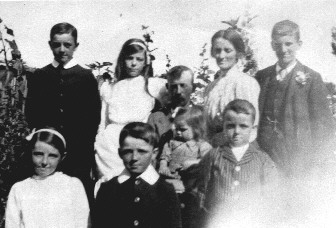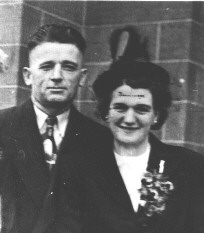
CHAPTER TEN Deep Lead :- Leaving the Land
Having given something of the background of Bridget Berry, the story can now be resumed from the time of her marriage to William James Bond. William worked at a variety of occupations including farming and mining and this is reflected in the number of different locations at which his children were born. John Charles (Charlie) was born on Dec 31st 1899 at Elliminyt near Colac. William then worked briefly as a coal miner at Outtrim in Gippsland 1 before returning to Birregurra where his son William was born in Sept 1901. Theresa (later Mrs McFarlane) was also born in Birregurra on August 8th 1903. Shortly afterwards the whole family moved. Alexander was born at Horsham on April 6th 1905; possibly the family was living at Lower Norton (not far from Horsham) at this time as this was the birthplace of Jessie (later Mrs Parsons) - born on June 30th 1906. However by the time Francis was born on July 25th 1909, the family was living beside the Western Highway in the once flourishing but by then largely deserted gold mining settlement of Deep Lead, a few miles west of Stawell. Another baby had been stillborn between these last two mentioned, and had been buried at Nurrabiel. 2

William and Bridget Bond photographed with their family at Deep Lead. Eileen is being nursed by her father. The other children from l-r are :- Bill, Trese, and Charlie (at the back) and Jessie, Alec and Frank (in front)
At Deep Lead the family then shifted again, this time into a house that had once belonged to the manager of the "A1" gold mine. The house was located on the south side of the Lake Lonsdale road between the abandoned "A1" and "Band of Hope" mines. All that remained of the house at the time of my last visit in 1997 were the foundations and chimney, although at an earlier visit in 1980 the open mine shaft could still be seen just a few metres from the ruins of the house.
William had to struggle to support his young family. His land was uncleared scrub and hence unsuitable for farming or grazing. He made ends meet by taking whatever work was available in the district such as assisting with ploughing or clearing on nearby larger properties (including Ledcourt Station) or by collecting and carting wood to be railed to Horsham where it was burnt to fuel the boilers of the large flour mills. That money was scarce at times is indicated by a recollection of the children being gathered into the house by their mother and being told to remain perfectly silent whilst she ignored the knocking on the front door by the local travelling Chinese green-grocer who had presumably called seeking payment for fruit and vegetables that had been supplied on credit. The land also lacked water and it is recalled that during the dry summer months the children on at least one occasion were sent the mile or so to the railway station, which was on the main Melbourne-Adelaide line, to obtain water from a passing train. After filling the empty tank that had been brought for that purpose the precious liquid was transported back to the family home. 3
It was at Deep Lead also that Mona Gladys was born in 1912, but she lived for only a few months before dying on Sept 30th of that year. She is buried in the Deep Lead cemetery. 4 Eileen was also born at Deep Lead on April 12th 1915. She was the youngest of the family although another baby was stillborn after this. Whilst living at Deep Lead most of the children had the opportunity of receiving some education at the local state school, a single-roomed brick building which although now disused is still standing beside the highway, just past the cemetery but on the opposite side of the road.
In the meantime both of William's parents had passed on. As already mentioned Charles had returned from the Colac district around 1904 and settled at Lower Norton. As this corresponds to the time that William came to the same district it is possible that they were in some kind of partnership. It was at Lower Norton that Charles died suddenly on Sunday Jan 6th 1909, being only 56 years at the time. He was buried at Nurrabiel. 5 Following the death of her husband Betsy returned to Colac, presumably to live with her daughters who conducted a dressmaking business there. It was in Colac that she died on April 18th 1913. Her body was taken by rail to Horsham in order to be buried with her husband at Nurrabiel. 6
The Bond family moved to Geelong in May 1919. William and two of his sons Alec and Frank made the journey by horse and cart via Stockyard Hill, Skipton and Rokewood, taking five to six days. Bridget and the girls travelled by train to Birregurra where they stayed with relatives before the family was reunited at Highton. From there the family shifted to Belmont where they lived in a house close to the Barwon bridge until 1926 when they moved to "Tyneside" on the Torquay road also in Belmont. 7 William took up employment with the Victorian Railways and his keen interest in Union affairs saw him serve as President of the Geelong Branch of the Federated Engine Drivers and Firemen's Association for the period 1923-24. 8 Alec's formal schooling ceased the day he left Deep Lead (he was then in Grade Six) but Jessie, Frank and Eileen all attended St Bernards Primary School in Belmont. 9 One by one the children grew up and married with most settling in Geelong.
In 1934 William and Bridget, together with any of their children who were still living at home, moved again and occupied a house at 84 Little Myers Street, where apart for a brief period when he worked in Melbourne, William was to remain for the rest of his life. William died of cancer in the Geelong Hospital on Sept 16th 1942, and was buried at the Eastern Cemetery in Geelong. A cut in his lip which failed to heal due to his pipe-smoking, developed into a cancer. Bridget survived her husband by almost six years; her death occured on June 17th 1948 in Geelong, and she was buried with her husband.
Alexander Henry Bond married Winifred May Cassidy at St Mary's Church in Geelong on October 31st 1936. They settled at 15 Darling St East Geelong where their family grew to embrace six children including the author of this account. 10 The history of my mother's family is another story which will be told later in this book but those of the other descendants of William and Bridget are stories that are better known and therefore better told by someone else. 11

My parents, Alec and Win Bond
GO TO FOOTNOTES CHAPTER TEN
GO TO CHAPTER ELEVEN
RETURN TO CONTENTS PAGE